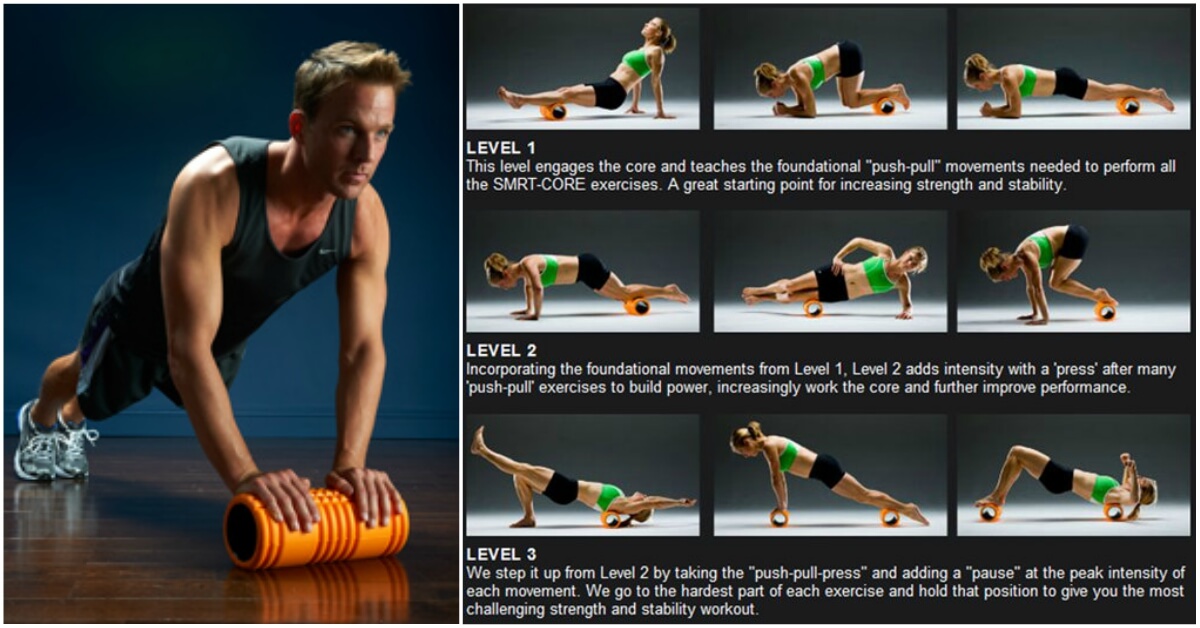The benefits of foam rolling are due to the mobility of the fascia. Fascia is a fibrous layer of connective tissue that surrounds all of the muscles in our body. Without proper mobility, fibres of the fascia become cross linked and they bind to muscles and nerves, inhibiting normal motion and causing pain.
Stretching can be more beneficial if foam rolling is done prior to the stretch. Using a foam roller increases hip range motion after rolling on the hamstring then stretching, compared to stretching alone. Increase in flexibility is from increased blood flow and an increase in intramuscular temperature, both of which increase the viscoelastic properties of muscle.
Static stretching prior to exercising is not beneficial and could actually be injurious. Static stretching should be performed after exercise, when muscles are relaxing and returning to their normal length.
Let’s try this concept with a foam roller and incorporate into strength building as well as stretching.
- Make pull-ups harder by placing the foam roller between your legs and keeping your knees up at 90 degrees.
- To build great glutes, do a straight leg version of a glute bridge by positioning the foam roller under your calves.
- Improve rear foot elevated squats by setting up a barbell in a power rack and sliding a foam roller over it.
- Increase the challenge of ab rollouts using a foam roller. Pump your chest and delts with foam roller push-ups
1. Pull-Ups: Make Them Harder And Stricter


This is the overhead squat of the pull-up.
These can cut your numbers by 20-30%. If 15 pull-ups is your standard, don’t be surprised if you only get 10-12 with this method.
Putting the knees at 90 degrees gives a co-activation of the lats, since part of the muscle originates at the hip. Add the foam roller for abduction and you get a double workout of abdominal wall and abductor contraction that forces you to stay locked in and stiff.
It’s also a quick and convenient way to advance pull-ups without a dip belt or weight vest to add load.
2. Preacher Curl For Your Glutes


Using the foam roller forces glute recruitment to bridge as opposed to digging into the hamstring for assistance. It’s a solid movement for hip activation.
Place the roll under one leg. The closer you place it to your knee, the easier it becomes. Placing it closer to the foot lengthens the leaver.
Before bridging, drive the leg straight as an arrow, squeezing your quad while dorsiflexing the ankle (raising toes toward knee). It’s only a 3-4 inch bridge, but it’s effective. Just 1-2 sets of 10 to start a lower body session will do your hips good.
3. Customise The Rear Foot Elevated Split Squat


Use a hollow, PVC style foam roll. Slide it over a barbell and set the bar up in a power rack around mid-calf height.
This movement is often done with the rear foot elevated too high, which puts a greater stretch on the rear quad and limits depth or makes the hip externally rotate and compensate, making it need more mobility.
The little bit of cushion on the roll allows for more comfort since the foot doesn’t have to go into deep plantar flexion like it does when on a bench.
4. Ab Rollouts More Effective
Use this as a progression from an ab wheel. You’ve got to try it to understand it.
Keep these in a low to moderate rep range, multiple sets of 5-8 reps. Going high rep on them can make the low back kick in.
5. Ramp Up Your Push-Ups


It’s a modification similar to doing med ball push-ups, but with less stress on the wrists and elbows.
Use two rolls. They should run lengthwise with your body, allowing you to wrap your hand around it so you basically have a neutral grip. The foam rolls give a hint of instability, which increases shoulder stabilizer and torso activation.
This variation allows for a greater stretch at the bottom range. Do 2-3 sets at the start of training sessions to get blood into your pecs and shoulders.
Or use them at the tail end of a session for 2 sets of max reps, going to complete failure. Once to failure, do partials from the bottom position and finally try to squeeze an isometric hold for 5 seconds with your nose hovering right above the floor.
You’ll completely exhaust the pecs and shoulders and finish off an upper body session.


Beginners: You don’t get better at push-ups by doing half push-ups! You may require a simple technique fix. But if it’s just a lack of strength, an easy adjustment is to put a foam roll under the knees and start with full-range push-ups here.
If you can bust out 6-8 with the roll at the knees, the next step is to move it down to the shins. After conquering the shins, it’s time to go for the full.


Thoracic Rotation Stretch
This isn’t a strength movement. It increases shoulder and thoracic mobility – things you need in order to train hard.
First, sit hips back to heels. When the hips pass 90 degrees in this child’s pose position, it effectively puts the lumbar spine in an immovable position.
Then reach one arm out and push that hand into the ground. Same concept as the lumbar spine – you anchor one shoulder down which will allow for more pure thoracic rotation.
Place the other arm on the foam roll. Rotate and roll across the body, trying to get every inch out of the stretch.
Do a set of 10 on each side before an upper body lift.

